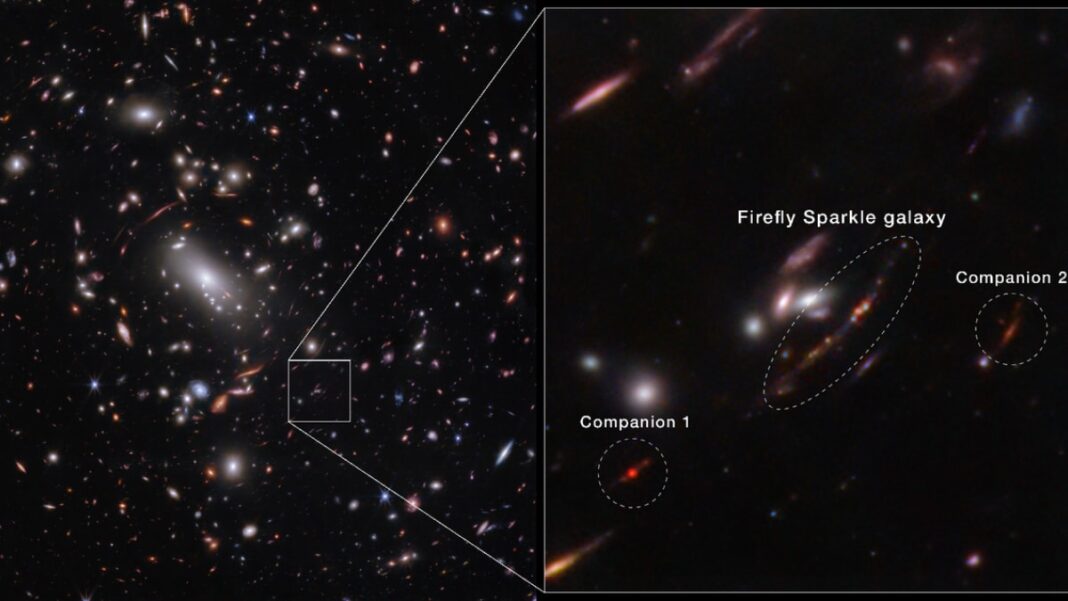A galaxy nicknamed the Firefly Sparkle has been discovered by NASA’s James Webb Space Telescope, marking a significant breakthrough in our understanding of the universe. This galaxy, detected approximately 600 million years after the Big Bang, holds a mass akin to the Milky Way at a similar developmental stage. The insights gained from this discovery shed light on the early universe, offering a glimpse into a time when galaxies were just beginning to form and evolve.
The Story So Far
Imagine a time when the cosmos was still young, a period when stars were just beginning to twinkle in the vast expanse of space. In this era, a galaxy known as the Firefly Sparkle emerged, its presence a testament to the beauty and complexity of the universe. With ten active star clusters shimmering within its depths, this galaxy stands out as a beacon of light in the darkness of space.
Researchers delved into the mysteries of the Firefly Sparkle, uncovering a fascinating tapestry of star formation. Unlike other galaxies of its time, this celestial wonder displayed a staggered pattern of star birth, each cluster evolving at its own pace. Through the lens of the James Webb Space Telescope, the Firefly Sparkle revealed itself as a delicate arc, its form distorted by the gravitational pull of a massive galaxy cluster.
Chris Willott, the principal investigator behind this groundbreaking discovery, marveled at the diversity of star clusters within the Firefly Sparkle. Each cluster, he noted, was in a distinct phase of evolution, painting a vivid picture of cosmic creation and transformation. Thanks to gravitational lensing, astronomers were able to peer deep into the heart of this ancient galaxy, unraveling its secrets one star at a time.
Galactic Neighbours and Future Evolution
As the Firefly Sparkle dances through the cosmos, it is accompanied by two neighboring galaxies, poised to shape its destiny over billions of years. These cosmic companions, located at varying distances from the Firefly Sparkle, are expected to influence its growth through intricate interactions and merging processes. The intricate dance of these galaxies offers a glimpse into the dynamic nature of the universe, where celestial bodies interact and evolve in a delicate cosmic ballet.
This remarkable discovery is part of the Webb’s CAnadian NIRISS Unbiased Cluster Survey (CANUCS) program, a testament to the power of collaboration and exploration in unlocking the mysteries of the universe. Through the lens of the James Webb Space Telescope, we are granted a front-row seat to the cosmic drama unfolding before our eyes, offering a glimpse into the formative years of the universe.
Conclusion
The discovery of the Firefly Sparkle galaxy is a testament to the ingenuity and perseverance of astronomers around the world. Through their tireless efforts and dedication, we are granted a glimpse into the early universe, a time when galaxies were just beginning to take shape. As we continue to unravel the mysteries of the cosmos, one thing remains clear: the universe is a vast and wondrous place, filled with beauty and wonder beyond our wildest dreams.
Frequently Asked Questions
- What makes the Firefly Sparkle galaxy unique?
- The Firefly Sparkle galaxy stands out for its ten active star clusters and staggered star formation process.
- How was the Firefly Sparkle galaxy discovered?
- The galaxy was detected by NASA’s James Webb Space Telescope, offering unprecedented insights into the early universe.
- What role does gravitational lensing play in observing the Firefly Sparkle galaxy?
- Gravitational lensing enhances the visibility of the galaxy, allowing astronomers to resolve its components and study its intricate details.
- How do the neighboring galaxies influence the evolution of the Firefly Sparkle galaxy?
- The interactions with nearby galaxies are expected to promote the mass growth of the Firefly Sparkle through merging processes over billions of years.
- What is the significance of the Webb’s CAnadian NIRISS Unbiased Cluster Survey (CANUCS) program?
- The CANUCS program provides unparalleled insights into the formative years of the universe, offering a unique perspective on the evolution of galaxies.
- Who is Chris Willott, and what role did he play in the discovery of the Firefly Sparkle galaxy?
- Chris Willott is the principal investigator behind the research, leading the team that uncovered the diverse star clusters within the Firefly Sparkle.
- Why is the Firefly Sparkle galaxy considered a significant discovery in astronomy?
- The galaxy’s existence sheds light on the early universe and offers unique insights into the formation and evolution of galaxies after the Big Bang.
- What makes the Firefly Sparkle galaxy’s star clusters different from other galaxies of its time?
- The Firefly Sparkle’s star clusters display a staggered pattern of star formation, indicating a diverse range of evolutionary stages within the galaxy.
- How does the James Webb Space Telescope contribute to our understanding of the Firefly Sparkle galaxy?
- The telescope’s advanced technology allows astronomers to observe the galaxy in unprecedented detail, revealing its intricate structure and star clusters.
- What does the discovery of the Firefly Sparkle galaxy teach us about the early universe?
- The galaxy’s characteristics provide valuable insights into the conditions and processes that shaped galaxies in the early universe, expanding our knowledge of cosmic evolution.
Tags: Firefly Sparkle galaxy, James Webb Space Telescope, early universe, cosmic evolution, star clusters, gravitational lensing, galaxy formation, astronomical discovery, Webb’s CAnadian NIRISS Unbiased Cluster Survey, cosmic companions, cosmic evolution.
- The galaxy’s characteristics provide valuable insights into the conditions and processes that shaped galaxies in the early universe, expanding our knowledge of cosmic evolution.

